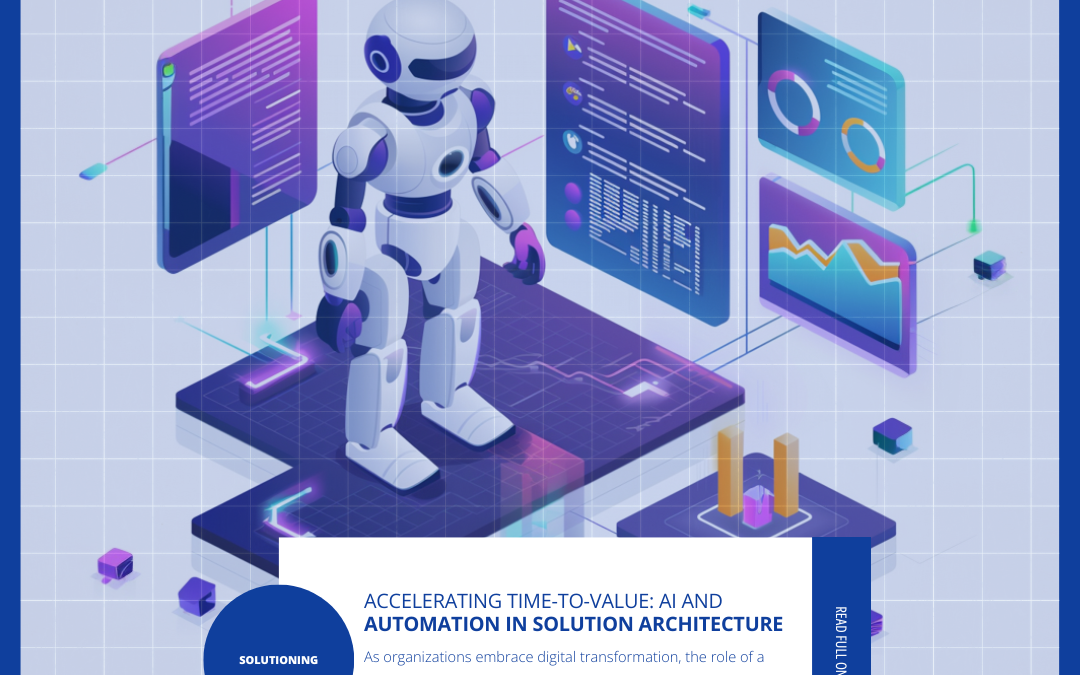In today’s hyper-competitive business landscape, organizations are under constant pressure to innovate and deliver value to their customers faster than ever before. At the heart of this challenge lies the need to accelerate time-to-value — the time it takes for an organization to realize the benefits of its investments and initiatives. To address this imperative, businesses are increasingly turning to the power of artificial intelligence (AI) and automation, and at the forefront of implementing these transformative technologies are solutions architects.
Traditionally tasked with designing and implementing complex systems and applications, solutions architects now find themselves at the intersection of technology and business strategy, driving digital transformation initiatives forward. With AI and automation, these architects are empowered to streamline workflows, optimize processes, and unlock new opportunities that shape the future of business and technology.
The evolving role of a solutions architect
Traditionally, solutions architects have been responsible for designing and implementing complex systems and applications to meet specific business needs. However, as technology continues to evolve, their role has expanded to encompass a broader range of responsibilities, including leveraging AI and automation to drive business outcomes.
Harnessing the power of AI
AI technologies, such as machine learning and natural language processing, are revolutionizing the way organizations operate. Solutions architects can harness the power of AI to automate repetitive tasks, analyze vast amounts of data, and uncover valuable insights. By integrating AI into their solutions, architects can improve decision-making processes, enhance user experiences, and drive operational efficiency.
For example, AI-powered chatbots can be deployed to provide instant customer support, reducing the need for human intervention and improving response times. Similarly, machine learning algorithms can analyze customer data to personalize marketing campaigns, increasing customer engagement and loyalty.
Streamlining workflows with automation
Automation plays a crucial role in accelerating time-to-value by streamlining workflows and eliminating manual processes. Solutions architects can leverage automation tools to orchestrate complex tasks, automate software deployment, and optimize resource allocation.
By automating repetitive tasks, such as software testing and deployment, architects can significantly reduce time-to-market and improve overall productivity. Additionally, automation enables organizations to scale their operations more efficiently, allowing them to adapt to changing market conditions and customer demands.
Real-world scenario
Let’s consider a real-world scenario where a solutions architect leverages AI and automation to accelerate time-to-value:
Scenario:
A large e-commerce company is looking to improve its recommendation engine to provide personalized product recommendations to its customers.
Solution:
The solutions architect designs and implements an AI-powered recommendation engine that analyzes customer browsing behavior, purchase history, and demographic data to generate personalized product recommendations in real-time. Additionally, the architect automates the deployment process using continuous integration/continuous deployment (CI/CD) pipelines, allowing for rapid iteration and deployment of new features.
Result:
By leveraging AI and automation, the e-commerce company is able to deliver highly targeted product recommendations to its customers, resulting in increased sales and customer satisfaction. The automated deployment process ensures that new features and updates are rolled out quickly and efficiently, enabling the company to stay ahead of the competition.
In practice, the impact of AI and automation on accelerating time-to-value can be profound. Consider the scenario we reviewed of a large e-commerce company seeking to improve its recommendation engine to provide personalized product recommendations to its customers. By leveraging AI and automation, a solutions architect can design and implement an AI-powered recommendation engine that analyzes customer data in real-time to generate personalized product recommendations. Through automated deployment processes, new features and updates can be rolled out quickly and efficiently, driving increased sales and customer satisfaction.
As organizations continue to embrace digital transformation, solutions architects will play an increasingly critical role in shaping the future of technology and driving business success. By harnessing the power of AI and automation, architects can accelerate time-to-value, drive innovation, and deliver tangible business outcomes. As the pace of change accelerates, organizations that prioritize AI and automation will be better positioned to stay ahead of the competition and thrive in the digital age.
Want to learn more about a company that is spearheading showcasing time-to-value for their clients? Check out HCLTech’s new AI Force.

A.I Create & Sell Unlimited Audiobooks to 2.3 Million Users – https://ext-opp.com/ECCO
A.I Create & Sell Unlimited Audiobooks to 2.3 Million Users – https://ext-opp.com/ECCO
A.I Create & Sell Unlimited Audiobooks to 2.3 Million Users – https://ext-opp.com/ECCO
CyUqjsld
yGaHDfcstSTqgMp
adQSUArqNilw
YLkyHdGq
FXtSxwqHme
gHNLThRU
zPbFKtDHT